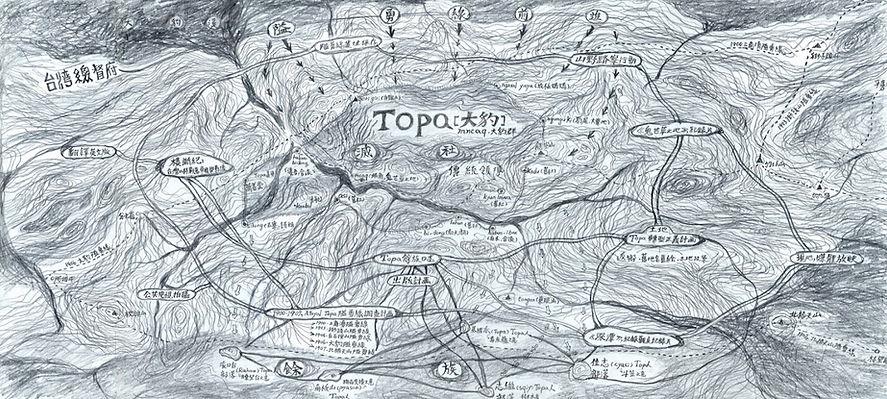高俊宏 Kao JunHonn
《大豹:溫帶的邊界》
Topa: Temperate Boundary, 2017
「棄路:一位創作者的地理政治之用」(個展)
Abandoned Path: A Creator's Geopolitical Method, Solo Exhibition
亞洲藝術中心 A+ Contemporary project, Asia Art Center, Taipei
複合媒材裝置、紀錄文件、踏查工作坊
Mixed media installation, documentation, workshop
尺寸因空間而異 Dimensions Variable
《大豹 : 溫帶的邊界》是一段隱藏於新北市郊山的事件,關於泰雅族大豹社消失的過程。作品透過年余的山野隘勇線調查,近百件戰爭遺跡的測繪,以及延伸出來的錄像拍攝,其用意,並不在 於“再現”這段過往事跡,而是藉由藝術行動,從台灣自身長期的被侵略史裏面,重新創造出新的感知以及具有批判性的生命主體與力量。“溫帶”一詞對於位處亞熱帶、熱帶的台灣島嶼,意 味著一種外來的溫度,更是某種形式的國家邊界。
Ncaq: The Border of Temperate Zone is an event buried in the suburban mountain region in New Taipei City; it is about the gradual disappearance of Atayal Ncaq tribe. This work is a result of years of research on barrier defense lines in the mountains, surveying and mapping on hundreds of war relics as well as extended documentation and filming. The work’s intention is not to“re-enact”this piece of history but to create a new perception and a subject and force with criticality through artistic actions from the roots of Taiwan’s own long history as a victim of invasions. The term“Temperate Zones”, for the island of Taiwan as situated in the subtropical / tropical region, signifies a foreign touch and even a country’s boundary of a certain form.

《棄路》展場圖
報導:藝術很有事26—大豹社事件隘勇線研究
Report:Inside the Arts 26 —Research of Dabao Incident
《棄路》展場圖

《棄路》展場圖,樟木

《線》Line, 2018
單頻彩色有聲影像 Single channel video, color, sound 11’27’’



